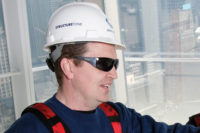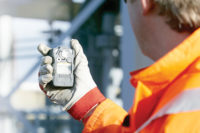Face the facts
How to pick the proper faceshield

Eye and face injuries cost more than $300 million per year in lost production time, medical expenses and workers’ compensation claims.1 Most of these injuries could have been prevented with the proper selection and use of eye and face protection. In an effort to decrease the risk of these types of injuries, OSHA has established safety guidelines for workplaces, incorporating, by reference, the American National Standard for Occupational and Educational Personal Eye and Face Protection Devices (the “standard”).
This article will focus on simplifying the process of selecting face protection products by providing a better understanding of the requirements for these products. Faceshields are an important part of personal protective equipment (PPE) and are designed to protect a worker’s entire face and neck (if the proper length faceshield and/or a chin protector is used) from flying objects and debris, heat, chemical splashes or other potentially dangerous hazards. We will explore product variations available and provide guidance on how to properly match a faceshield to a particular hazard to meet standard requirements.
About ANSI/ISEA Z87.1-2010 Standard
The most recent version of the standard, ANSI/ISEA Z87.1-2010, sets criteria related to the general requirements, testing, permanent marking, selection, care and use of protectors to minimize the occurrence of injuries from such hazards as impact, non-ionizing radiation and chemical exposures in work environments such as machinery operations, material welding and cutting, chemical handling, and assembly operations, to name a few.
The standard is organized by hazard (rather than protector type), and outlines requirements for eye and face protectors as well as test methodologies that products must pass to comply.
ANSI/ISEA Z87.1-2010 markings
Eye/face protectors claiming compliance with ANSI/ISEA Z87.1-2010 will have the applicable markings as shown in the standard:
- Each lens must be marked with manufacturer’s identity;
- All components must be marked “Z87.” A “+” is added if the protector is impact rated (Z87+);
- Markings for lens features, type and use, as claimed by the manufacturer, must be identified, including, but not limited to: welding, ultraviolet (UV) filter, visible light filter, IR filter, and splash droplet.
The importance of lens quality
Studies have shown that visual strain may cause health issues, such as debilitating headaches and a higher prevalence of musculoskeletal disorders. Additionally, if a protective device impairs vision, workers tend to wear it incorrectly to compensate, or remove it altogether2 — strongly increasing the risk of serious injury, as well as workers’ compensation claims and other costs. Eliminating offending causes of visual discomfort can reduce health issues and improve productivity.3
How to measure lens quality
ANSI/ISEA Z87.1-2010 provides guidance as to the requirements and test methods4 needed to meet the applicable “Optical Requirements.” Under ANSI/ISEA Z87.1-2010, protectors must:
- Be free of visible defects;
- Have a luminous transmittance level > 85 percent (if the lens is clear);
- Not exhibit >3 percent haze;
- Be within acceptable tolerance levels for refractive power, astigmatism, resolving power, prism and prism imbalance5.
General vs. impact-rated protectors
Some PPE users mistakenly believe that if an eye/face protector has a “Z87” marking on it, it has an impact rating. This is not the case.
Under ANSI/ISEA Z87.1-2010, there are two types of protectors: general and impact-rated.
General protectors do not provide impact protection as they do not pass the impact requirements outlined in the standard. General protectors are marked with “Z87” only. Some examples of general protector faceshields could include those made of mesh, Polyethylene Terephthalate Glycol (PETG), and acetate.
Impact-rated protectors pass the impact requirements and are marked Z87+, with the “+” designating an impact rating. Polycarbonate faceshields, for example, are likely impact rated.
Faceshield materials and features
When choosing a faceshield, first assess possible environmental hazards. Is there excessive glare, humidity or exposure to IR radiation? Is there a risk of impact, chemical splash, arc flash hazards or some combination of these?
To ensure proper hazard protection, it is important to better understand the faceshield materials used, as well as faceshield features such as tints, shades and coatings.
Materials
Faceshields are commonly constructed from the following materials:
Polycarbonate (PC) provides the best impact and heat resistance of all materials. While generally not known for its chemical resistance, some PC faceshields can provide resistance to chemicals, depending on thickness and coatings. Additionally, UV filter additive can be included for UV protection. If you want UV protection, confirm that the product has a “U” marking — U6 is the highest measurable level in the standard.
Propionate (PROP) provides chemical splash resistance against many types of chemicals. As a rule, PROP cannot meet impact requirements, but there are PROP faceshields in the market that are thicker and can provide both impact and chemical resistance. Check the product markings for Z87+ if you want both impact and chemical resistance in one faceshield.
Mesh faceshields provide maximum ventilation in humid working conditions and are designed to protect the face from flying debris. This faceshield is well-suited to some outdoor applications, like landscaping. As a rule, mesh faceshields do not provide impact or UV protection.
Acetate tends to be scratch- and chemical-resistant. It does not provide good levels of resolving power, however, and can cause eyestrain after long periods of use. Acetate faceshields generally do not pass impact requirements. Acetate also has very few sources of supply, so it can be costly.
PETG offers chemical splash protection. While PETG is plentiful, optically correct PETG has very few sources of supply. As a result, like acetate, it may not provide adequate levels of resolving power and may cause eyestrain after periods of use. Additionally, PETG generally does not pass impact requirements.
Features
There are a few more considerations when selecting a faceshield to ensure that visual discomfort is minimized and a worker is properly protected. Select a faceshield with all of the features needed, realizing that some features are not available with certain materials.
Clear lens – provides maximum light transmission and is good for indoor applications or outdoor use in low-light conditions.
Tinted lens – helps alleviate eye strain and fatigue by reducing excessive glare and light transmittance. A green tint is great for outdoor use, in bright-light conditions. Tint levels are not defined in ANSI/ISEA Z87.1-2010. For example, “medium green” faceshields may vary in color and light transmittance from manufacturer to manufacturer. Ensure you have the right level of light transmittance by reviewing any “L” markings on the faceshield: the higher the L number, the darker the tint as less light is transmitted through the lens.
Shade IR lens – helps protect against Infrared (IR) light. It is ideal for metal pouring, gas soldering, light cutting and brazing applications.
Arc lens – helps protect against low-level arc flashes. Specially tinted lens offers protection from electromagnetic energy, fragments and molten metals that could be released during an electric arc. Additional PPE may be needed for arc hazards, so be sure to assess these hazards properly.
UV filter additive – According to the Environmental Protection Agency (EPA), UV radiation increases the likelihood of cataracts, tissue growth that blocks vision, skin cancer, and degeneration of the macula. All of these problems can be decreased with eye protection that offers UV protection which filters 99-100 percent of UV rays.6 Many PPE users believe that wearing UV-rated spectacles under faceshields will serve this purpose; however, a UV-rated faceshield provides protection for the entire face, not just the eyes.
If a manufacturer is claiming UV protection levels under ANSI/ISEA Z87.1-2010, the protector will be marked with a “U” marking. A “U6” provides the highest level of UV filtering measured in the standard. Additionally, under the standard, users can (and should) request proof of UV protection claims from the manufacturer making such a claim.
Coatings
Anti-Fog and Anti-Scratch (AF/AS) – ANSI/ISEAZ87.1-2010 does not specify either a test methodology or marking indication for AF/AS, so when manufacturers claim AF/AS performance, there’s no true basis for comparison. Faceshields with AF/AS that pass EN166 tests for resistance to distorted vision due to lens fogging, and surface damage by fine particles, respectively, are something to seek if you want measurable performance.
EN tests for AF/AS are particularly difficult to pass. Faceshields with AF/AS have secured EN markings (N for anti-fog and K for scratch resistance). To secure an “N” marking, four water, air and relative humidity-conditioned visor samples are subjected to water vapor (steam). The time required for the light transmission levels to drop to 80 percent of the unfogged baseline is measured, and faceshields must remain fog-free for a minimum of 8 seconds. To secure a “K” marking, two clean visor samples are rotated on a plate while 6.6 lbs (+ 0.11 lb) of natural quartz sand is dropped from a nearly 5-ft.-tall gravity fed tube. Once the test is complete, the samples are cleaned and the measured light transmission must remain within tolerance.
Reflective – these “mirrored” coatings are designed to reflect and dissipate radiant heat, keeping the wearer’s face and neck comfortable in elevated temperature environments. These visors tend to be costly, as they are commonly coated with a gold alloy composition.
Train and maintain
Once you’ve grasped a firm understanding of standard requirements and selected the proper face protection to protect your workers from specified hazards, you must identify how you’ll train your employees and enforce your mandated plan to ensure successful compliance. Workers must understand what PPE is necessary and when to use it; how to inspect their PPE for wear or damage; and how to don, doff and adjust the fit of the PPE. In addition, employees need to be trained on how to care, store and clean their PPE.
Footnotes
1 OSHA Directorate of Technical Support and Emergency Management (2008); http://www.osha.gov/SLTC/eyefaceprotection/index.html.
2 Banerjee A. Effectiveness of eve protection in the metal working industry. BMJ7 1990;301:645-6 (20 September)
3 Hemphälä H, Eklund J., A visual ergonomics intervention in mail sorting facilities: effects on eyes, muscles and productivity. Appl Ergon. 2012 Jan;43(1):217-29. Epub 2011 Jul 2. PubMed PMID: 21726852.
4 ANSI/ISEA Z87.1-2010, sections 5.1 and 9.1-9.4, respectively.
5 The ANSI/ISEA Z87.1-2010 standard does not provide a requirement for refractive power or astigmatism for faceshields.
Looking for a reprint of this article?
From high-res PDFs to custom plaques, order your copy today!







